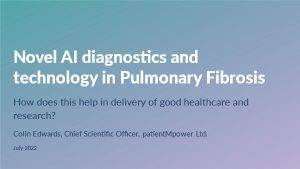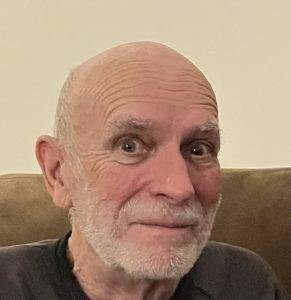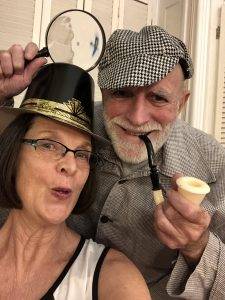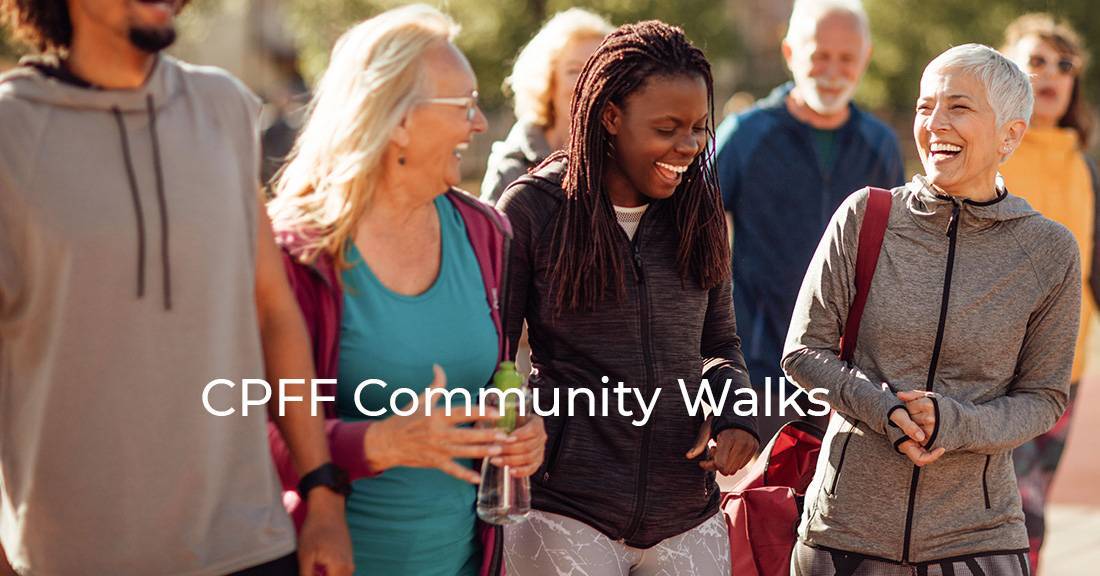It’s time to walk, roll, run and have fun in support of PF

Whatever the challenge, Canadian Pulmonary Fibrosis (CPFF) supporters have always risen to the occasion to raise awareness, hope and funds for people living with pulmonary fibrosis. This is especially true during Pulmonary Fibrosis Awareness Month in September.
This year a couple of folks held advance events during the summer. John Dennis helped us kick off early awareness efforts in June with his “I ride for you and me,” campaign, riding his electric bike along PEI’s The Island Trail. To date, John’s campaign has raised more than $25,000 and garnered plenty of local media attention and social media followers.
Heather Davidson of Markham, Ontario, held a garage sale and her grandchildren, aged 7 and 9 sold lemonade and bracelets during the sale. The kids raised $70 and Heather raised $565 for the cause.
You can set up your own event and ask for participants and/or pledges. Everything you need can be found at www.hopebreatheshere.com, including a DIY fundraising toolkit with downloadable social media graphics, a customizable poster and so much more to help you promote your event.
Already several people have done so, including Andres Moran-MacDonald, a fourth-year student at Queen’s University. This year, he’s been working on researching interstitial pulmonary fibrosis (IPF) as part of his co-op at St. Paul’s Hospital in Vancouver, British Columbia. He is running in the Subaru Ironman Canada – Penticton on August 28th and will be donating 1/2 of his proceeds to CPFF to support people living with PF.
Once again, the Clarke family will be holding its walk in Calgary, Alberta. And individual walks are being organized in Markham, Ontario and Winnipeg, Manitoba. You can join a community walk or pledge an individual or team event by visiting https://p2p.onecause.com/cpffwalk. You can also learn all about the people hosting the events and why they are supporting CPFF.
From coast-to-coast people are gathering to walk, roll, and run. Our goal is to collectively walk across Canada by the end of September 2022. That’s 6,818 kilometers!
Get the CPFF app

We have made it easier for you to get informed, stay connected and have fun year-round! Start browsing upcoming Pulmonary Fibrosis Awareness Month in September educational webinars, community walks and events, plus monument lightings. Connect with others in the CPFF community, post PF walk kms, participate in CPFF challenges and more.
Explore the CPFF Community app today! Browse from your computer: https://eventmobi.com/cpff/.
Download the mobile app from:
Apple App Store: https://apps.apple.com/ca/app/cpff/id1634273710 or
Google Play: https://play.google.com/store/apps/details?id=com.cpff.emcpff
September is for learning

The fall is when we traditionally turn our minds to learning new things – a hold-over from our school days. During Pulmonary Fibrosis Awareness Month, we’ve lined up some great speakers to expand your knowledge of PF and related topics. n the meantime, here are the speakers, topics, dates and times (all in EDT), so you can mark your calendar.
All of the upcoming webinars can be found now on the new CPFF app. (See the article above for details on how to download the app on your Smart phone or browser.) They will also be listed on our new website launching later this month. It will be a breeze to just click to watch and listen live or to view the recorded version.
Upcoming Webinars
Wednesday, September 7, 1:30 to 2:30 p.m.
Tracey Reed, dietician
Anti-inflammatory diet for PF
Thursday, September 8, 1:30 to 2:30 p.m.
Dr. Richard Allen
The genetics of PF
Tuesday, September 13, 2 to 3 p.m. (instead of National Support Group session)
Audrey Bond-Vaultt
An app for patients & caregivers
Wednesday, September 14, 1:30 to 2:30 p.m.
Dr. Marcelo Cypel
Creating universal blood-type organs for transplant
Thursday, September 15, 1:30 to 2:30 p.m.
Karine Diedrich
Advance care planning
Tuesday, September 20, 2 to 3 p.m. (instead of National Support Group session)
Dr. Amanda Grant-Orser and Dr. Kerri Johannson
Genetics and ILD: A Canadian primer
Wednesday, September 21, 1:30 to 3:30 p.m.
Todd Georgieff
What you should know about clinical trials
Tuesday, September 27, 2 to 4 p.m. (instead of National Support Group session)
Dr. Elisabeth Saxton
Mental health
Wednesday, September 28, 1:30 to 3:30 p.m.
Colin Edwards
Novel AI diagnostics and technology in PF
Thursday, October 13, 1:30 to 3:30 p.m.
CPFF
2022 Hope Breathes Here wrap-up and applause
Artificial intelligence and technology offer remote care and new research capabilities for pulmonary fibrosis

On July 25, the European Pulmonary Fibrosis Federation (EU-IPFF) hosted a presentation “Novel AI diagnostics and technology in Pulmonary Fibrosis. How does this help in delivery of good healthcare and research?” Speaker Colin Edwards, Chief Scientific Officer of patientMpower Ltd., gave a good overview of the explosion in health care technology and how it is rapidly becoming incorporated into patient care and how the data collected is being used in PF research.
Edwards will also offer his webinar to Canadians during Pulmonary Fibrosis Awareness Month in Canada on Wednesday, September 28, beginning at 1:30 p.m. EDT. Register here to participate.
During the pandemic, most of us became much more familiar with digital meetings replacing in-person ones – with friends and family, employers and healthcare providers. This has accelerated our comfort level with these technologies, as well as the creation of new developments in the field. We are also beginning to discuss the limits of the remote delivery of health care services.
Colin Edwards begins his presentation with some interesting data. Before 2007, and the proliferation of smart phones, there were no healthcare applications, or apps. By 2022, there are an estimated 350,000 health/wellness apps with Google Play store offering 52,000 health/medical apps and Apple App store offering about 50,000. The remaining apps are available on other, smaller, platforms.
About 12 per cent of the leading therapeutic areas for a successful digital health solution address respiratory health – fifth on the list. The top therapeutic area is mental health.
As a director and shareholder of patientmpower.com, a healthcare company providing remote monitoring in lung and kidney disease, Edwards used the firm as an example of the benefits of remote monitoring.
While home spirometry (measuring lung capacity as Forced Vital Capacity or FVC) has been around since 2000, today the devices are smaller, easier to use, with a longer battery life, more reliable, with results similar to in-person clinic measurements, and can send data via a smart phone directly to a healthcare provider or to the medical records of an institution, such as a hospital. It can also send data to be stored remotely, in the “cloud.”
Edwards explains how home monitoring can address three concerns in respiratory care. First, in-home monitoring with hospital-grade diagnostics, can reduce the need for in-clinic visits by about half, freeing up hospital time. Second, it can help prevent emergency visits, by identifying issues earlier through ongoing monitoring and automated (using AI) alerts. Thirdly, it can qualify patients for treatment, by identifying patients suitable for new drug treatments with automated alerts using prescribing criteria.
He also bases several conclusions about the usefulness of AI and technology (particularly on home spirometry) on studies conducted by others, including Canadian researchers. These conclusions include the following:
- Home spirometry trends over time give a good indication of respiratory health
- Patients generally agree that sending data from home is usually better than going to a clinic to record the same type of information
- Smartphones and apps function well and are user-friendly
- Most people are willing to record data regularly and for a long time
- Many of these people are willing to share their data (pseudonymised) for research.
- This data collection will optimize the design of future studies
- A better understanding of all the data from many people is vital for research.
Be sure to check out all our educational offerings for Pulmonary Awareness Month 2022.
MAiD offered Frank Driscoll the choice to have his “good death”

Frank Driscoll was no stranger to his own mortality. A shooting accident when he was twelve left him with one leg considerably shorter than the other after a long hospital stay and considerable medical interventions. It was no surprise then that he hoped for a “good death” while asleep at home. Unfortunately, pulmonary fibrosis had other plans for him. In 2016, he was diagnosed with “stable” idiopathic pulmonary fibrosis (IPF), first by a doctor in Costa Rica, where he and his wife Jude wintered for many years, and then confirmed by doctors at home in Charlottetown, PEI.
For five years his life continued largely unchanged, with minimal symptoms, but in the spring of 2021 he experienced an acute exacerbation, while in Costa Rica. Frank had heart palpitations and profuse sweating, says his wife Jude. They went to the hospital in Costa Rica where he had extensive testing and was seen by the same respirologist who diagnosed him in 2016.
This time, during his six-minute walking test, his oxygen level went down to 81 per cent. The respirologist recommended that Frank fly home with oxygen and have a CT scan done as soon as possible. A CAT scan was already booked for their return. Along with his IPF, Frank also had GERD (gastroesophageal reflux disease) and nasal drip, which can both contribute to possible lung infection and complications.
In May, Frank began taking anti-fibrotic medication, which he tolerated well. In terms of oxygen, he had stationary and portable tanks, as well as back up for the power outages. But, his decline continued. Their daughter, who has a rare genetic condition, and lives near them in PEI, could also see that her father was losing weight and getting weaker.

costume party in happier times.
“He said that he was fading away,” says Jude, “because he could no longer haul wood or dig in the garden.” Fortunately, he loved to read the paper, talk with his buddies and worked on a memoir. He had plenty to remember. When he retired, he was the Chief Sherriff of PEI. And in his 20s, he travelled around the world and he and his wife travelled extensively in Central America. He loved adventure and meeting the local people. “I think his ability to explore made the end of his life a kind of adventure for him that he explored with both mind and heart,” says Jude.
He had plenty to remember. When he retired, he was the Chief Sherriff of PEI. And in his 20s, he travelled around the world and he and his wife travelled extensively in Central America. He loved adventure and meeting the local people. “I think his ability to explore made the end of his life a kind of adventure for him that he explored with both mind and heart,” says Jude.
In August 2021, the respirologist offered them referrals for home care and MAiD (Medical assistance in dying). Frank asked for both. Home care began with biweekly nursing monitoring.
In October, Frank and Jude travelled to the Yukon to visit their two sons and meet their first grandchild. “We spoke with them about MAiD and dying with dignity. Our youngest son remembers Frank saying he appreciated having the option, given the terminal nature of his condition,” says Jude. “He also remembers that Frank was frank and reasonable about death and wanted a good death with family near.
By this time, Frank who was mentally sharp until the end, had all of his affairs in order. Estate planning was done and he had his Advanced Care Directive done, indicating comfort measures only. “Frank was all about quality of life and taking care of business,” adds Jude.
Frank considered a transplant, but decided it was not for him and his family. Going through the health directives process had the couple think seriously about various options. In addition, a book club meeting that discussed the book Curtains by Tom Jokinen, had them thinking about how various cultures approach death and grieving.

By Christmas 2021, Frank was using oxygen 24/7, but could still walk six minutes down to the parking area, says Jude. But, by Easter this year, he was in a wheelchair as he could only walk 20 steps.
Integrative palliative care began when he had trouble with mobility and he needed a hospital bed for comfort. “He called it his Command Central,” says Jude. It had a bedside table, where he could work on his memoir or eat a meal if he was too tired to walk to the table.
The Driscolls’ lives slowed down drastically.
“Frank needed to rest after getting up from his bed,” says Jude. “Actually after almost any movement, he needed to rest for five to 15 minutes. I ended up being the cook, which he had always done. And I assisted with all his care: medications, urinal, warm rice bag for nausea and purchasing cannabis gummy bears for his nausea. Talking on the phone, Frank would speak the most important things and then I would tell them where we were at. We slept together every night and the coughing was managed by the pain meds and the CPAP machine, including with oxygen, the last six months. It was an exhausting time for me as a caregiver and we were unaware that we could hire private help.”
And the pandemic created challenges getting medical care. “We didn’t think that we would be able to get help during this time because of the shortage of health care staff,” says Jude.
The Home Care Nurse Manager was the primary contact with Frank’s medical doctor. There was no respite care available and there was no hospital bed available for a medication adjustment phase as recommended by Frank’s family doctor, due to COVID. The Palliative Care Center was full with a waiting list for a month or more.
Twice Jude and Frank went to emergency as recommended by a nurse and a doctor, but both times they were sent back home. And two months before Frank died, it took home care three weeks to provide once weekly bathing assistance and two hours of respite for Jude. “Not enough in my opinion,” says Jude.
Another huge gap in care was that they did not know until weeks before Frank’s death that there was a list of nursing staff available for hire. Eventually they got a list of licensed practical nurses (LPNs) available to help care for Frank. One consistent LPN for two hours a day made a huge difference.
Socially too, the couple were limited to meeting with one other couple “in their bubble” during the pandemic.
By Easter, Frank and Jude had talked to MAiD staff about making arrangements for Frank to die at home. A date and time need to be coordinated with the attending medical staff. The Home Care Nurse Manager helped to secure the necessary signature on a Notice of Expected Death at Home form, which meant the police would not be called and no autopsy would be performed following his medically expected death.
Frank’s sons and three sisters, as well as 95-year-old friend he regarded as a second mother, were all supportive of his decision. As was Jude. They all knew he did not want to die in hospital, especially considering his traumatic experience as a boy. Frank received the Sacrament of the Sick the week before he died.
On May 16, 2022, Frank, 74, met with each of his immediate family members individually to say goodbye. It took about an hour, then Frank rested. “We all knew it was his time to be at peace,” says Jude.
He wrote a birthday card for his daughter. He greeted the MAiD providers with kind words and welcome. One of them had to confirm in private with Frank that he wished to proceed.
After giving Jude a “stand-up” hug and saying how much he loved her, he walked to his hospital bed with Jude holding his hand. Once he was comfortable, their oldest son held his right hand and Jude his left hand. A close friend sang the hymn Peace is Flowing Like a River. After the injection, Frank’s grip seemed to let go within about two minutes. MAiD directives require that six minutes pass before death can be declared. Frank Driscoll passed away at 4:37 p.m.
Frank was hugged and lovingly swaddled in a blue and white blanket and the family stayed with him for about two hours, before the funeral home attendants arrived.
How is Jude doing, six weeks later? “I initially felt relieved that his suffering was over. I also felt exhausted. Now, I feel lonely. Deep love equals deep loss, after 45 years together. The rest of our family is at peace. Grief is a process that is very individual and it goes on as the memories are always with us.”
What advice would she give others considering MAiD? “Throughout the last nine months we prayed for peace and courage. Mentally, emotionally and physically, IPF takes its toll. Exploring your medical options as early as possible is best,” she says.
“Only you will know how you feel and what you need. Medical assistance in dying is legal and can or cannot be controversial, it depends on your mindset and knowledge. Many people have not completed their health directives. For us they were the beginning of serious self examination. The same with doing our Wills. They all involve very personal decisions.”
Editor’s note: For more information about MAiD (Medical assistance in dying), visit: https://www.canada.ca/en/health-canada/services/medical-assistance-dying.html. The Dying with Dignity website also has helpful information, including various case examples and concepts, explained by health care professionals.
One more step in the nintedanib campaign

Thanks to many of you in our PF Community, nintedanib (Ofev) is now available for patients with progressive fibrosing interstitial lung diseases (PF-ILDs) in each province and territory, with the exception of Nunavut. While many of its population will be covered by the First Nations and Inuit (NIHB) Non-Insured Health Benefits, also now listing Ofev for PF-ILDs, we hope it will add it to its general formulary soon.
The Canadian Pulmonary Fibrosis Foundation is now encouraging you to reach out to your MPP/MLA to thank their government for providing fair access to this medication. Please visit https://cpff.ca/get-involved/advocate/current-initiatives/ and fill out the online message form and it will be delivered directly to your MPP/MLA.
“Saying thank you in this case is more than simply good manners,” says Sharon Lee, CPFF’s Executive Director. “It helps us build our relationships with elected officials, so that they are more likely to consider other requests. And, everyone deserves to be thanked for their contributions that help others.”

coming soon….
CPFF is launching its new and improved website this month with all the info and features you asked for
Later this month, the Canadian Pulmonary Fibrosis Foundation (CPFF) will launch its new and improved website, just in time for Pulmonary Fibrosis Awareness Month in September. Along with a fresh new look, there will be plenty of new and updated information, along with an all-important search function.
You’ll still find us at www.cpff.ca. The aim of our new website is to provide you with an easy-to-use site with credible information that you can use. Watch out for announcements on our social media sites.



